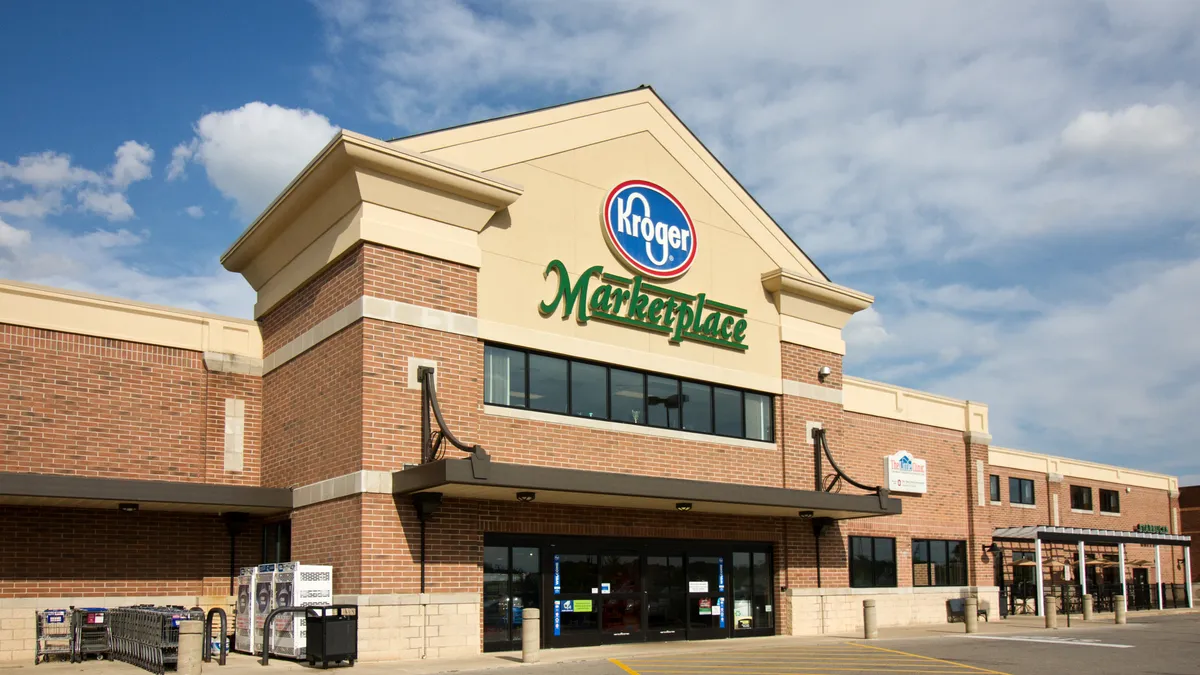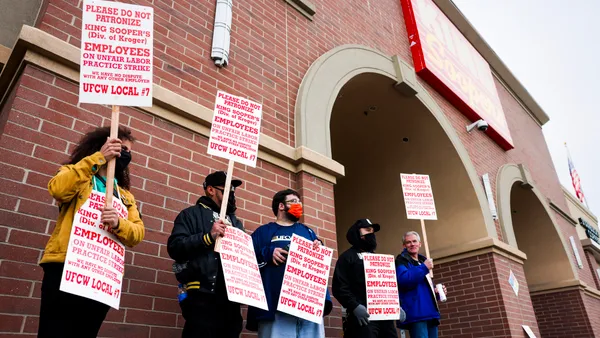Dive Brief:
- Kroger on Thursday reported weaker results during the third quarter, as sales fell slightly year-over-year, to $33.96 billion, and comparable-store sales excluding fuel were down 0.6% — the first time since the second quarter of 2021 that the grocery chain posted a negative figure for that metric.
- The company reported an operating profit of $912 million for Q3, reversing a second-quarter loss. Kroger also said that its comparable sales would have been positive during Q3 had it not ended its contract with Express Scripts at the end of last year.
- Kroger on Nov. 15 certified to the Federal Trade Commission that the company’s plan to merge with Albertsons is in substantial compliance with the agency’s requirements, CEO Rodney McMullen said Thursday during an earnings call.
Dive Insight:
Kroger has continued to work “cooperatively” with the FTC to iron out details of its deal to combine with Albertsons and is moving toward closing the transaction by early 2024, according to McMullen.
“We are confident that we have fulfilled all the commitments we set out in the original merger agreement, including the comprehensive divestiture plan announced with C&S Wholesale Grocers,” McMullen said during the call, referring to Kroger and Albertson’s arrangement to sell more than 400 stores and other assets to C&S to assuage anti-trust concerns stemming from the merger plan.
McMullen said teams from the grocers have made “significant progress” toward the companies’ goal of ensuring that the deal does not cause disruption for its workers or customers.
“It is exciting to see the complementary strengths of both organizations and how we’ll be able to learn from each other to provide customers with an even stronger food retail experience and compete even more effectively against larger non-union operators in the future,” McMullen said.
Kroger's year-over-year change in same-store sales
While Kroger dealt with headwinds during Q3, the grocer was able to strengthen ties with shoppers during the period by focusing on value, McMullen said. The company has seen budget-conscious shoppers make more trips to its stores and buy larger quantities of goods, trends that helped the company record its 10th consecutive quarter of total household growth, he said.
CFO Gary Millerchip noted during the call that Kroger’s performance was impacted by declining inflation during Q3, adding that the trend has affected unit growth rates. While Kroger has sequentially improved units for four quarters in a row, unit growth has not improved at the rate the company would like to see, Millerchip said.
Kroger updated its guidance for all of 2023 and now expects that it will post same-store sales growth of between 0.6% and 1% for the year, down from its earlier prediction of a range of 1% to 2%.
"Today, we updated our full year guidance to reflect the impact of new term economic pressures and food at home disinflation,” Millerchip said during Thursday’s earnings call.
Kroger saw digital sales rise 11% in Q3, with pickup and delivery both up by double digits, according to McMullen. Kroger has also improved the profitability of its Ocado-supplied automated fulfillment facilities, and the company offers two-hour pickup at more than a third of its stores, he said.
McMullen added that the company has expanded its base of digitally engaged households by 13% during the period as it boosted digital offers and improved its personalization capabilities.
“Digitally engaged households are incredibly valuable to our model, as they are more loyal, spend nearly three times more with us and accelerate growth in our alternative profit businesses,” McMullen said.
Catherine Douglas Moran contributed reporting to this story.
Correction: A previous version of this story misstated Kroger's sales decline during the third quarter.













